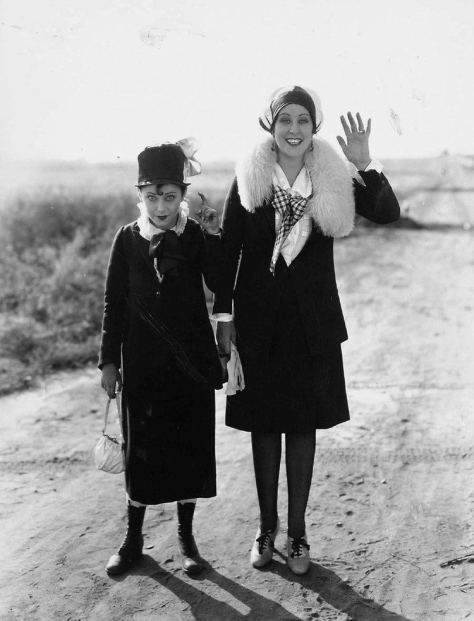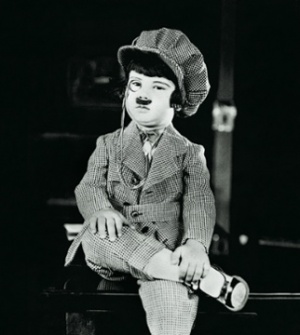These reviews of Slapstick Divas: the women of Silent Comedy by Steve Massa and Specters of Slapstick & Silent Film Comediennes by Maggie Hennefeld first appeared in the June 2017 and July 2018 issues of Sight & Sound, respectively. I am reposting them here ahead of a slew of events celebrating silent cinema comediennes coming up soon.

Slapstick Divas: the Women of Silent Comedy by Steve Massa
In the silent era, as now, film comedy looks a lot like a boys’ club – and that disparity is more deeply entrenched in the arena of physical humour. For those who would like to see Marie Dressler and Marion Davies, let alone Flora Finch and Anita Garvin, as celebrated as their male peers, Steve Massa’s Slapstick Divas: the Women of Silent Comedy, will be a welcome resource. A followup to Massa’s survey of lesser-known male silent comedians, Lame Brains and Lunatics, Slapstick Divas tells an engrossing tale of female performers beating a path in the silent film industry.
An entire chapter is devoted to the most famous slapstick comedienne of them all, Mabel Normand, who segued from modelling work to acting, first in Vitagraph comedies and then at Biograph where she played dramatic roles for D.W. Griffith, but was happier putting over gags for Mack Sennett. Normand would become a fixture at Sennett’s new Keystone studio, starring in ever more physically demanding films. The chapter is named after a Photoplay description of Normand as “the sugar on the Keystone grapefruit”, but her work was as rough-and-tumble as her peers. “I have fought with bears, fallen out of a rapidly moving automobile, jumped off a second story roof into a flower bed and risked life, limb and peace of mind in innumerable ways,” she told the Los Angeles Times in 1916. She appeared in several films with Charlie Chaplin, including the feature Tillie’s Punctured Romance (1914) and was regularly paired with Roscoe “Fatty” Arbuckle. Although she was later dismissive of her skills behind the camera, she directed several films too, including Mabel’s Strange Predicament (1914), Chaplin’s first performance as the Tramp. Sadly, an accident on set one day contributed to Normand’s slow decline. While she continued to act into the 1920s, her career faltered owing partly to a series of scandals, but mostly her increasingly erratic behaviour in the studio, and gaunt appearance on film, consequences either of her brain injury, or her drug use. She died from tuberculosis in 1930, aged 37, and although she is the star of this volume, Massa notes that “her work has rarely been screened and her talent has been taken for granted”.

If Normand doesn’t get the recognition she deserves, many of the other names featured in this expansive book are at risk of complete obscurity. Even for a silent film aficionado there will be unfamiliar names here. Massa’s rigorous research leaves no comedienne behind, not even the ranks of juvenile toddler stars (the most famous is Baby Peggy, but there were many more) and the canine comedienne, Cameo, whose perfect timing and nonchalant stance led to her billing as “the Buster Keaton of dogdom”. Massa dedicates chapters to various categories of silent comedienne, from the earliest screen comics to leading ladies of the teens and 20s, women working behind the camera and “distaff duos” (even Massa admits they were thin on the ground). This is followed by an impressively exhaustive encyclopaedia of female silent comics: miniature biographies of performers from English-born stage star turned movie actress Gypsy Abbott, who married film director Henry King, to Turkish-born actress Flora Zabelle, who appeared with Arbuckle, Normand, John Barrymore and her husband Raymond Hitchcock.
In his introduction, Massa notes that previous silent comedy histories have ignored the contribution of female performers, with one notable book suggesting comediennes were rare because it’s impossible to be funny and pretty at the same time. That’s not a difficulty Normand ever seemed to encounter, and though there are a few bathing beauties in these pages (most notably Marie Prevost), for many women, an off-kilter appearance was a ticket to success. Many women here used their unusual looks to get laughs, such as skinny, pinch-faced Flora Finch, so often paired with John Bunny, or plump star of Al Christie comedies Babe London, whose career dried up when she followed her doctor’s order to reduce her excess weight. Other attractive young actresses such as Louise Fazenda, Alice Howell or Fay Tincher gamely dressed drably or eccentrically to get a giggle, with outsized spit curls, unflattering dresses and pallid foundation.
This entertaining and lavishly illustrated book will become an invaluable reference for silent comedy historians, and provides a fresh look at a familiar field.

Specters of Slapstick & Silent Film Comediennes by Maggie Hennefeld
Long represented as a male domain, slapstick comedy of the silent era was in fact home to many female performers, and even directors. Growing interest in the role of women in early cinema has prompted the celebration and recognition of these women, their skills and their popularity. Maggie Hennefeld’s rich and provocative book, Specters of Slapstick & Silent Film Comediennes, carries us several steps further in our understanding of a pivotal period in cinema history.
Hennefeld takes the early and transitional eras as her subject and investigates how actresses performed slapstick on screen for a variety of audiences and strategies. Along the way, she posits a refreshing and productive new approach to transitional cinema, and challenges received ideas about the development of narrative film and screen comedy. She makes time to explore the value and purpose of laughter, to reappraise D.W. Griffith’s early comic work and to examine the political impact of Suffragette comedies. Hennefeld’s opening argument is that the corporeality of female comics shaped the development of the fiction film: “Slapstick comediennes are the specters of our earliest film histories.” And it all begins with exploding domestics.

In a rash of trick-enhanced films such as Mary Jane’s Mishap (1903 and one of my many British films discussed) or The Kitchen Maid’s Dream (1907), female servants combust, or are dismembered (or both) in the kitchen. Hennefeld argues that this is a reflection of both a concerning real-life trend danger brought about by the Victorian fashion for hooped skirts (“crinoline conflagrations”) and the dangerous clash of the female body with technology (the housemaid and the domestic appliance/the actress and the film camera), a creative collision on the path to the formation of narrative cinema. In the popular British film Daisy Doodad’s Dial (1914) Florence Turner mugs away as Daisy, a housewife keen to enter a face-pulling contest. Daisy grimaces further when she first contracts a painful toothache, then is arrested for clowning in public. Alone in her bed and tormented by nightmares, she is haunted by superimpositions of her own distorted features. Similarly, when Mary Jane is forced up the chimney following a kitchen explosion, her dismembered limbs rain down to earth only to reassemble in ghostly form so that she can haunt her own gravestone (etched with the grim joke “rest in pieces”). For Hennefeld, the destruction and reconstruction of female bodies in this strain of comic cinema represents the growing pains of the medium itself: “comediennes’ wayward bodily gestures perform the inconsistency and incongruity of films from this period”.
Like many of the arguments in this engaging book, it’s a compelling theory, not least because Hennefeld so deftly throws the emphasis on to strands of early cinema that are underexplored or have been explained away elsewhere. With D.W. Griffith, Hennefeld first rescues the director’s slapstick efforts from the dustbin of critical oversight then moves to debunk the “myth of male authorship by revealing the repressed places of slapstick comediennes as counter-authorial forces in his filmmaking”. Mabel Normand, heroine of many a Griffith comedy also appeared in the director’s melodramas and in those films, thanks to her “corporeal unruliness”, embodied the former of two female types identified by the director: the voluptuary and the spirituelle. The slapstick comedienne takes her place in opposition to the waif, typified for Griffith by the ethereal Lillian Gish.

The third part of the book is devoted to “Slapstick Politics” and the meanings and motives of films that dealt with the campaign for female suffrage. These range from whimsical affairs imagining a topsy-turvy world run by women such as When Women Win (1909) to more vicious attacks on the campaigners themselves, including the notorious depiction of a male chauvinist fantasy Milling the Militants (1913). The import of “cartoonish abuse inflicted on suffragette bodies” is clear, but the intended response to carnivalesque fantasies of matriarchal authority can be less clear: should they, asks Hennefeld, “provoke disciplinary mockery, or revolutionary laughter”? Perhaps neither, and both, as “nonsense” is one way to navigate a period of social and political turmoil.
Hennefeld’s book concludes with a call to “make visible the forgotten histories of feminist social struggle and of women’s cultural visibility”. Rather neatly, Specters of Slapstick offers an engrossing and energizing example of that very work.
- Slapstick Divas: the Women of Silent Comedy is available now from Bearmanor Media.
- Specters of Slapstick & Silent Film Comediennes is available now from Columbia University Press.
- There are several silent female comedy events coming up soon as part of the BFI Comedy Genius season. There’s a screening of four Mabel Normand shorts, with a new live score by the Meg Morley trio at BFI Southbank on 22 October, which will then tour across the UK.
- BFI Southbank is also screening Mickey, starring Normand, with live music on 23 October & 29 November.
- I will give an illustrated talk on Anita Loos as part of the Broad Strokes: Trailblazing Comedy Screenwriters event at BFI Southbank on 28 October.
- Bryony Dixon and I will be discussing silent comediennes at BFI Southbank on 29 November, with clips and live accompaniment by John Sweeney.
- And of course, the Slapstick Festival takes place in Bristol, 16 January-10 February 2019.
- Silent London will always be free to all readers. If you enjoy checking in with the site, including reports from silent film festivals, features and reviews, please consider shouting me a coffee on my Ko-Fi page.

I’ll have to make a visit to my local library. Great stuff. RE-posted on twitter @trefology